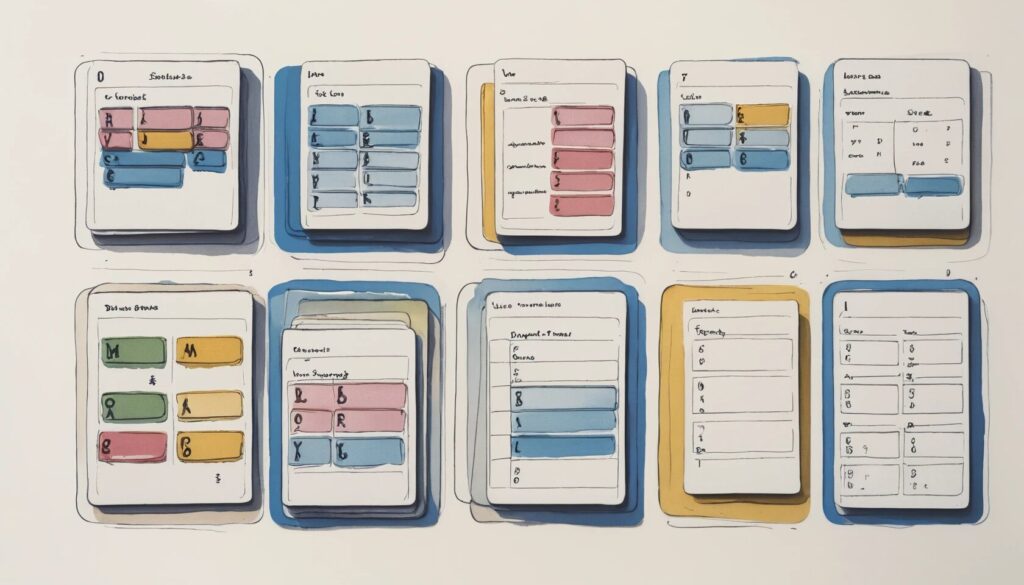Why Card Sorting is the Secret Weapon of Smart Designers
- Card sorting helps designers create intuitive website structures.
- It reveals how users categorize and understand information.
- There are different types of card sorting, each with unique benefits.
- Understanding participant-centric analysis can enhance research results.
Ever wondered why some websites feel like a treasure map designed by a toddler, while others guide you effortlessly to the information you need? The secret lies in card sorting techniques—an essential part of user experience research that ensures your website doesn’t make users want to throw their devices out the window.
Let’s be honest: if your website’s navigation is a labyrinth, your visitors won’t stick around long enough to find the exit. Card sorting is a tried-and-true method to build an intuitive information architecture that aligns with how real humans think, not just how designers wish they would.
Understanding the Core Card Sorting Techniques
- Open card sorting: Participants create their own categories.
- Closed card sorting: Participants sort items into predefined categories.
- Hybrid card sorting: A mix of open and closed sorting methods.
Before you start tossing digital index cards around, it’s crucial to understand the three main website design methods for card sorting. Each serves a unique purpose and offers different insights into user behavior.
Open Card Sorting: This approach lets participants create their own groups. If you’re launching a brand-new site and have no idea how users might categorize content, this is a great place to start. It’s a bit like giving someone a messy pile of LEGO bricks and letting them build whatever they want.
Closed Card Sorting: Here, participants are constrained to predefined categories. This is ideal when you have an existing framework but want to validate whether users understand it. Think of it as giving someone an IKEA manual and seeing if they can still assemble the bookshelf correctly.
Hybrid Card Sorting: The best of both worlds. Participants use predefined categories but can also create their own if necessary. This method balances structure and flexibility, providing deeper insights into user expectations.
How to Set Up a Successful Card Sorting Study
- Define clear research goals before starting.
- Choose the right participants to get meaningful results.
- Use digital tools to streamline the sorting process.
A successful card sorting study doesn’t happen by accident—it’s meticulously planned. First, you need to define your research goals. Are you testing a new navigation structure? Validating an existing one? Understanding your objectives will shape the entire process.
Next, choose the right participants. Your mom and best friend might be eager to help, but unless they represent your actual users, their input is about as useful as a chocolate teapot.
Making Sense of the Data with Participant-Centric Analysis
- Traditional analysis methods can oversimplify results.
- Participant-Centric Analysis (PCA) focuses on individual sorting behaviors.
- PCA reveals deep insights into how different users think.
Once your participants have sorted their cards, it’s time to make sense of the chaos. Traditional analysis methods often focus on aggregate trends, but this can hide important nuances. Enter Participant-Centric Analysis (PCA), a method that looks at how individuals categorize information rather than just overall trends.
Why does this matter? Because not all users think the same way. Some may group content based on function, while others focus on emotional or personal relevance. PCA helps uncover these patterns, providing a richer understanding of user behavior.
Common Mistakes to Avoid in Card Sorting Studies
- Using too many or too few cards.
- Ignoring inconsistencies in user categorization.
- Failing to test with a diverse participant pool.
Card sorting is powerful, but it’s easy to mess up. One of the biggest mistakes is using an overwhelming number of cards. If participants feel like they’re playing a never-ending memory game, they’re more likely to check out mentally.
Another pitfall is ignoring inconsistencies in categorization. If half your participants put “Contact Us” under “Support” and the other half put it under “Company Info,” that’s a red flag. Instead of averaging the results, dig deeper into why these differences exist.
Finally, diversity matters. If all your participants come from the same background or industry, your results will be skewed. A well-rounded participant pool ensures your site works for a broad audience, not just a niche group.
Why Card Sorting Should Be a Standard in UX Research
- It enhances website usability by aligning with user expectations.
- It reduces friction and frustration in navigation.
- It provides data-driven insights that inform design decisions.
If you think card sorting is just another UX buzzword, think again. It’s one of the most effective user experience research methods for improving website navigation. When users can easily find what they’re looking for, they’re more likely to stay on your site—and maybe even buy something.
Beyond usability, card sorting also reduces frustration. Nobody wants to feel like they need a Ph.D. in cryptography just to use a website. A well-structured information architecture ensures that visitors don’t have to play detective to locate basic information.
Most importantly, card sorting provides actionable, data-driven insights. Instead of relying on gut feelings or internal debates, you get real feedback from real users—something every designer should prioritize.
Final Thoughts: Make Card Sorting a Core Part of Your Design Process
- Card sorting is indispensable for intuitive website design.
- Choosing the right technique maximizes research effectiveness.
- Analyzing individual behaviors leads to deeper insights.
If you’re serious about designing a user-friendly website, card sorting techniques should be in your toolkit. Whether you’re working on a complete site overhaul or just tweaking navigation, this method ensures your website design methods align with user expectations.
Choosing the right approach—open, closed, or hybrid—can make all the difference. And don’t forget about participant-centric analysis; understanding how individual users think will give you a competitive edge.
So, are you ready to stop guessing and start designing with confidence? Try card sorting today and build experiences that make sense—no detective work required.
